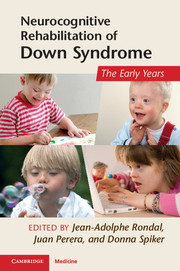Book contents
- Frontmatter
- Contents
- List of contributors
- Preface
- Acknowledgments
- Section 1 Definition, history, methodology, and assessment
- Section 2 Genetics, brain, and animal models
- Section 3 Pharmacological and medical management and treatment
- Section 4 Early development and intervention
- 10 Developmental models as frameworks for early intervention with children with Down syndrome
- 11 Aspects of motor development in Down syndrome
- 12 Memory development and learning
- 13 Prelinguistic and early development, stimulation, and training in children with Down syndrome
- 14 Speech perception, stimulation, and phonological development
- 15 Goal-directedness as a target for early intervention in Down syndrome
- 16 The role of parents of children with Down syndrome and other disabilities in early intervention
- Section 5 Therapeutic perspectives
- Conclusions
- Index
- References
14 - Speech perception, stimulation, and phonological development
Published online by Cambridge University Press: 05 July 2011
- Frontmatter
- Contents
- List of contributors
- Preface
- Acknowledgments
- Section 1 Definition, history, methodology, and assessment
- Section 2 Genetics, brain, and animal models
- Section 3 Pharmacological and medical management and treatment
- Section 4 Early development and intervention
- 10 Developmental models as frameworks for early intervention with children with Down syndrome
- 11 Aspects of motor development in Down syndrome
- 12 Memory development and learning
- 13 Prelinguistic and early development, stimulation, and training in children with Down syndrome
- 14 Speech perception, stimulation, and phonological development
- 15 Goal-directedness as a target for early intervention in Down syndrome
- 16 The role of parents of children with Down syndrome and other disabilities in early intervention
- Section 5 Therapeutic perspectives
- Conclusions
- Index
- References
Summary
Children with Down syndrome (DS) have poorer speech abilities than would be predicted on the basis of their cognitive functioning. This delay may be a result of poor control of articulators and decreased oral–motor skills or hearing difficulties, especially in the first years of life. How can we investigate the relative importance of these factors? It may be interesting to consider the development of phonological abilities in children with cochlear implants, as these children have difficulties with hearing, but do not also have issues with oral–motor skills. The aim of this chapter is to reevaluate the notion that speech and phonological difficulties in children with DS should be mainly conceived of in terms of speech production difficulties. Instead, the comparison with children with cochlear implants reveals that auditory deprivation within the first years of life may lead to a highly similar profile of speech processing deficits.
Phonological difficulties in children with Down syndrome
An uneven profile
In individuals with learning difficulties, there is a delay in the development of phonology, which is commensurate with the level of development in nonverbal mental age (Smith & Stoel-Gammon, 1983; Sommers et al., 1988; Dodd & Leahy, 1989). For children with DS, phonological abilities are below the level predicted on mental age alone (Abbeduto et al., 2001; Dodd & Thompson, 2001).
- Type
- Chapter
- Information
- Neurocognitive Rehabilitation of Down SyndromeEarly Years, pp. 182 - 190Publisher: Cambridge University PressPrint publication year: 2011



